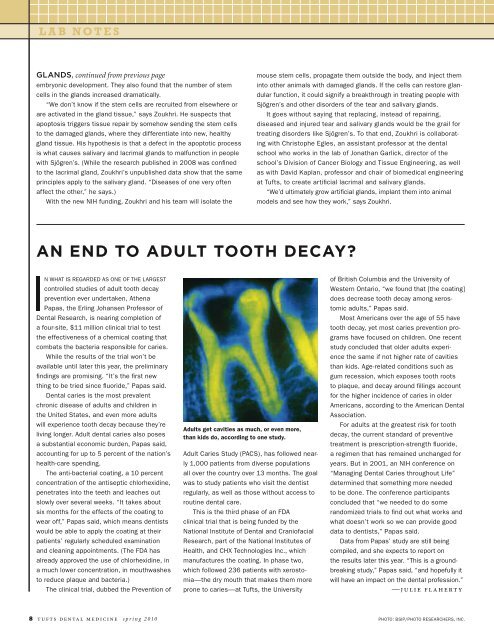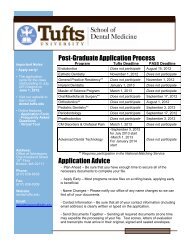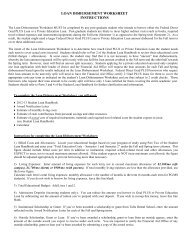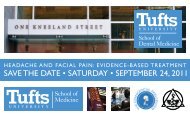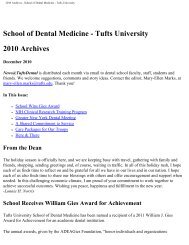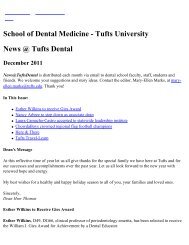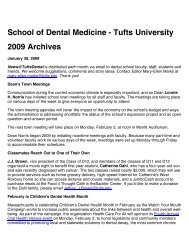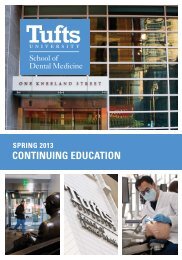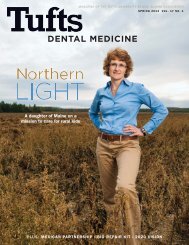Spring 2010 - Tufts University School of Dental Medicine
Spring 2010 - Tufts University School of Dental Medicine
Spring 2010 - Tufts University School of Dental Medicine
Create successful ePaper yourself
Turn your PDF publications into a flip-book with our unique Google optimized e-Paper software.
L A B NO T E S<br />
, continued from previous page<br />
embryonic development. They also found that the number <strong>of</strong> stem<br />
cells in the glands increased dramatically.<br />
“We don’t know if the stem cells are recruited from elsewhere or<br />
are activated in the gland tissue,” says Zoukhri. He suspects that<br />
apoptosis triggers tissue repair by somehow sending the stem cells<br />
to the damaged glands, where they differentiate into new, healthy<br />
gland tissue. His hypothesis is that a defect in the apoptotic process<br />
is what causes salivary and lacrimal glands to malfunction in people<br />
with Sjögren’s. (While the research published in 2008 was confined<br />
to the lacrimal gland, Zoukhri’s unpublished data show that the same<br />
principles apply to the salivary gland. “Diseases <strong>of</strong> one very <strong>of</strong>ten<br />
affect the other,” he says.)<br />
With the new NIH funding, Zoukhri and his team will isolate the<br />
mouse stem cells, propagate them outside the body, and inject them<br />
into other animals with damaged glands. If the cells can restore glandular<br />
function, it could signify a breakthrough in treating people with<br />
Sjögren’s and other disorders <strong>of</strong> the tear and salivary glands.<br />
It goes without saying that replacing, instead <strong>of</strong> repairing,<br />
diseased and injured tear and salivary glands would be the grail for<br />
treating disorders like Sjögren’s. To that end, Zoukhri is collaborating<br />
with Christophe Egles, an assistant pr<strong>of</strong>essor at the dental<br />
school who works in the lab <strong>of</strong> Jonathan Garlick, director <strong>of</strong> the<br />
school’s Division <strong>of</strong> Cancer Biology and Tissue Engineering, as well<br />
as with David Kaplan, pr<strong>of</strong>essor and chair <strong>of</strong> biomedical engineering<br />
at <strong>Tufts</strong>, to create artificial lacrimal and salivary glands.<br />
“We’d ultimately grow artificial glands, implant them into animal<br />
models and see how they work,” says Zoukhri.<br />
<br />
N WHAT IS REGARDED AS ONE OF THE LARGEST<br />
controlled studies <strong>of</strong> adult tooth decay<br />
prevention ever undertaken, Athena<br />
Papas, the Erling Johansen Pr<strong>of</strong>essor <strong>of</strong><br />
<strong>Dental</strong> Research, is nearing completion <strong>of</strong><br />
a four-site, $11 million clinical trial to test<br />
the effectiveness <strong>of</strong> a chemical coating that<br />
combats the bacteria responsible for caries.<br />
While the results <strong>of</strong> the trial won’t be<br />
available until later this year, the preliminary<br />
findings are promising. “It’s the first new<br />
thing to be tried since fluoride,” Papas said.<br />
<strong>Dental</strong> caries is the most prevalent<br />
chronic disease <strong>of</strong> adults and children in<br />
the United States, and even more adults<br />
will experience tooth decay because they’re<br />
living longer. Adult dental caries also poses<br />
a substantial economic burden, Papas said,<br />
accounting for up to 5 percent <strong>of</strong> the nation’s<br />
health-care spending.<br />
The anti-bacterial coating, a 10 percent<br />
concentration <strong>of</strong> the antiseptic chlorhexidine,<br />
penetrates into the teeth and leaches out<br />
slowly over several weeks. “It takes about<br />
six months for the effects <strong>of</strong> the coating to<br />
wear <strong>of</strong>f,” Papas said, which means dentists<br />
would be able to apply the coating at their<br />
patients’ regularly scheduled examination<br />
and cleaning appointments. (The FDA has<br />
already approved the use <strong>of</strong> chlorhexidine, in<br />
a much lower concentration, in mouthwashes<br />
to reduce plaque and bacteria.)<br />
The clinical trial, dubbed the Prevention <strong>of</strong><br />
Adults get cavities as much, or even more,<br />
than kids do, according to one study.<br />
Adult Caries Study (PACS), has followed nearly<br />
1,000 patients from diverse populations<br />
all over the country over 13 months. The goal<br />
was to study patients who visit the dentist<br />
regularly, as well as those without access to<br />
routine dental care.<br />
This is the third phase <strong>of</strong> an FDA<br />
clinical trial that is being funded by the<br />
National Institute <strong>of</strong> <strong>Dental</strong> and Crani<strong>of</strong>acial<br />
Research, part <strong>of</strong> the National Institutes <strong>of</strong><br />
Health, and CHX Technologies Inc., which<br />
manufactures the coating. In phase two,<br />
which followed 236 patients with xerostomia—the<br />
dry mouth that makes them more<br />
prone to caries—at <strong>Tufts</strong>, the <strong>University</strong><br />
<strong>of</strong> British Columbia and the <strong>University</strong> <strong>of</strong><br />
Western Ontario, “we found that [the coating]<br />
does decrease tooth decay among xerostomic<br />
adults,” Papas said.<br />
Most Americans over the age <strong>of</strong> 55 have<br />
tooth decay, yet most caries prevention programs<br />
have focused on children. One recent<br />
study concluded that older adults experience<br />
the same if not higher rate <strong>of</strong> cavities<br />
than kids. Age-related conditions such as<br />
gum recession, which exposes tooth roots<br />
to plaque, and decay around fillings account<br />
for the higher incidence <strong>of</strong> caries in older<br />
Americans, according to the American <strong>Dental</strong><br />
Association.<br />
For adults at the greatest risk for tooth<br />
decay, the current standard <strong>of</strong> preventive<br />
treatment is prescription-strength fluoride,<br />
a regimen that has remained unchanged for<br />
years. But in 2001, an NIH conference on<br />
“Managing <strong>Dental</strong> Caries throughout Life”<br />
determined that something more needed<br />
to be done. The conference participants<br />
concluded that “we needed to do some<br />
randomized trials to find out what works and<br />
what doesn’t work so we can provide good<br />
data to dentists,” Papas said.<br />
Data from Papas’ study are still being<br />
compiled, and she expects to report on<br />
the results later this year. “This is a groundbreaking<br />
study,” Papas said, “and hopefully it<br />
will have an impact on the dental pr<strong>of</strong>ession.”<br />
—julie fl a hert y<br />
8 tufts de ntal medicine sp r i n g 20 1 0<br />
PHOTO: BSIP/PHOTO RESEARCHERS, INC.


